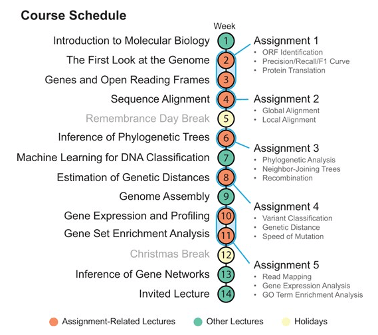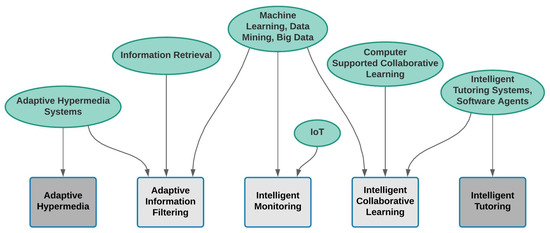Not known Facts About Bioinformatics Tutor
Not known Facts About Bioinformatics Tutor
Blog Article
The Ultimate Guide To Bioinformatics Tutor
Table of ContentsGetting My Bioinformatics Tutor To WorkThings about Bioinformatics TutorAll About Bioinformatics TutorThe Definitive Guide for Bioinformatics TutorSome Ideas on Bioinformatics Tutor You Should Know
Of the total individuals associated with the training, 80% were students from public college organizations, while the remaining 20% came from private establishments. To receive a certification of engagement, students were needed to participate in at the very least 90% of the total training hours. As an outcome of this need, an outstanding 95% of the individuals successfully acquired their certifications, having not only fulfilled the minimum participation requirements yet additionally finished all appointed activities throughout the training.
Throughout the elevation of the COVID-19 pandemic, specifically between June and August 2020, the job team was charged with organizing specialized training in bioinformatics. This training was specifically aimed at students from the research team Core for Research study in Applied Computing at the Federal University of Pará (UFRA) The adjustment to remote learning systems as a result of the pandemic developed an opportunity to discover brand-new training methodologies and digital tools that enhanced both reach and efficiency.
This training course was designed to offer an obtainable yet thorough introduction of Artificial Intelligence methods, particularly as applied in bioinformatics (Bioinformatics Tutor). This virtual format enabled participation from students across Brazil, many of whom could not have had the opportunity to attend in-person sessions.
How Bioinformatics Tutor can Save You Time, Stress, and Money.
A remarkable function of this program was its focus on hands-on understanding. Around 50% of the total training hours were committed to functional activities where pupils developed intelligent versions and applications in a series of scientific domain names, consisting of genetics, molecular biology, and environmental information evaluation. Extensively made use of tools and structures such as Spyder, Google Colab, Jupyter Notebooks, and Orange were integrated into the coursework. These systems enabled pupils to participate in real-time data control, model training, and formula experimentation.
Sixty of them were affiliated with numerous higher education establishments in the state of Pará, while the remaining twenty came from establishments located in five other Brazilian states. By introducing Artificial Intelligence in a sensible and pertinent context, the campaign offered to connect the void in between concept and real-world application, giving students with a solid foundation for future research or employment in the field.
The training initiative formed part of a wider academic outreach initiative called the Bioinformatics when driving project. This task has, throughout the years, presented loads of pupils to the globe of bioinformatics and computational biology. The occasions held under this umbrella campaign have actually taken place across several areas and years, as summed up in Table 1 (Checklist of occasions, locations, years, and overall varieties of trainees and teachers)
Among one of the most amazing end results of the Bioinformatics on the Roadway initiative has been its contribution to the growth of decentralized research study teams. Several of these groups, initially brought with each other by their participation in training events, have considering that gone on to produce independent clinical research in cooperation with regional academic establishments. The training not just promoted clinical reasoning within the context of bioinformatics but additionally sparked joint relationships that expanded past the training atmosphere. These collaborations have actually led to raised regional clinical productivity and added meaningfully to the advancement of the more comprehensive bioinformatics neighborhood in Brazil.
Bioinformatics Tutor Can Be Fun For Everyone
The project itself was conceptualized and organized by MB and RR, who managed the preparation and execution of each action. Lectures were supplied by a multidisciplinary group containing megabytes, FA, EF, KP, JS, DM, SN, LP, LG, RR, a/c, and ih. The same team, omitting IH and RR, likewise functioned as tutors for the functional training components. Funding for the project was provided through the grant 88887.200562/ 2018-00 from CAPES. The writers expand their gratitude to everyone that added to the realization of this project, whether directly or indirectly, given that its beginning.
The Federal College of Pará's Workplace of Research (PROPESP/UFPA) likewise gave economic assistance, specifically for the production of the final manuscript. The writers declare no financial or industrial disputes of rate of interest that can have influenced the study. In addition, all analyses and opinions shared in this write-up are entirely those of the writers and do not always reflect those of their corresponding organizations, the publisher, editors, or customers included in the magazine process.

Bioinformatics Tutor - Truths
From an instructional viewpoint, the teaching technique made use of in the training was deliberately interactive. Courses were performed in a manner that encouraged trainee engagement and discussion, surpassing memorizing memorization to discover exactly how concepts are created, used in every day life, and checked in scholastic settings. The training viewpoint concentrated on supporting both strong and battling students, providing personalized support, and building self-confidence through sustained mentorship and perseverance.

Each team, here including roughly 36 individuals, was sustained by 3 mentors-- a lot of whom were postdoctoral scientists with customized competence. These advisors not only assisted design the team jobs yet also promoted their execution, making sure that each study inquiry was both relevant and properly challenging. The goal was to offer a naturally practical context that individuals might discover via open-ended goals and access to curated datasets.
For extra insights right into the approach and results of this project-based learning technique, readers are directed to S1 Text, which consists of comprehensive descriptions of the pedagogical structure, analysis strategies, and job motifs made use of in the training sessions.
Not known Incorrect Statements About Bioinformatics Tutor
Of the total participants entailed in the training, 80% were trainees from public higher education establishments, while the continuing to be 20% came from exclusive organizations. To qualify for a certificate of engagement, trainees were required to participate in at the very least 90% of the total training hours. Especially, past the pupils that enlisted in the training sessions, seven skilled trainers took part in supplying the training courses, while 3 committed research study view it professors coordinated the general training process. Around 50% of the total training hours were committed to sensible tasks where pupils built intelligent versions and applications in a variety of scientific domains, consisting of genes, molecular biology, and ecological data analysis. The training not just fostered scientific thinking within the context of bioinformatics yet also stimulated collaborative connections that extended past the training environment.
Report this page